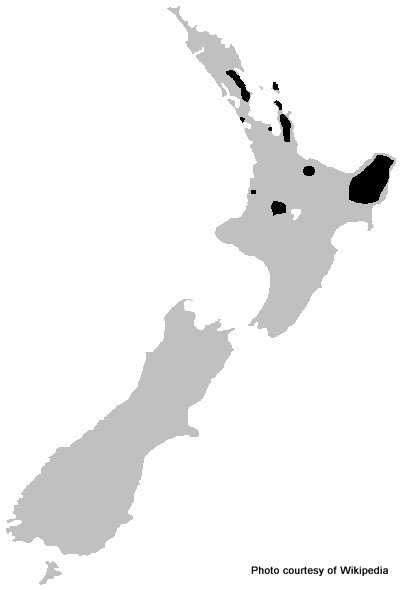Kingdom: Animalia
Phylum: Chordata
Class: Amphibia
Order: Anura
Family: Leiopelmatidae
Genus: Leiopelma
Species: L. hochstetteri
Binomial name: Leiopelma hochstetteri
Common name: Hochstetter's frog, Hochstetter's New Zealand frog
Leiopelma hochstetteri is a small primitive frog native to New Zealand, one of only four extant species belonging to the taxonomic family Leiopelmatidae.
Leiopelma hochstetteri like all New Zealand's endemic frogs are semi-aquatic, well camouflaged and are nocturnal. They are only found in at least 10 fragmented isolated pockets in damp areas along the edges of streams running through native forests and occasionally in pine plantations in the northern half of the North Island. There about 19 distinct Hochsetter frog populations they include areas in Great Barrier Island, Brynderwyn Hills, Hunua ranges, Waitakere ranges, Waipu, Mahurangi, Maungatautari Mountain, Raukumara Ranges, Coromandel peninsula, Otawa near Te Puke, Pureora Forest Park and in the Waikawau area.
During the day Leiopelma hochstetteri shelter primarily under rocks, logs, or leaf litter. They are active at night feeding on invertebrate prey (insects, worms, and snails) that they take hold of with their arms before gulping them down.
Female Leiopelma hochstetteri grows up to 50mm long, while male frogs grow up to 38mm long. Juvenile frogs can be as small as 7mm long. The adults have a brown-green to brown-red top with dark bands and warts and yellow-brown bellies. They have more warts than our other native frogs and also have partial webbing between the hind toes which other native frogs don’t have. They do not crock.
Males of this species exhibit sexual dimorphism in the form of more muscular, robust forelimbs than females. This is another distinctive trait, as the other three Leiopelma species are not sexually dimorphic, apart from females reaching greater body size.
Adults do not breed until they are three years old, laying up to 20 eggs each season. During mating, the male clasps the female around the waist and fertilises her eggs as they are laid, primarily under stones, fallen vegetation, or sometimes in tunnels bored by dragonfly larvae.
Leiopelma hochstetteri is the only New Zealand frog species to have a stream-dwelling larval stage (tadpole). The males do not carry their young around on their back like the other New Zealand native frog species do. Leiopelma hochstetteri can live to 30 years old.
The Department of Conservation (DOC) has classified the Hochstetter's frog as “At Risk” species.
Thanks to Wikipedia for text and Information: http://creativecommons.org/licenses/by-sa/3.0/
Thanks also to The IUCN Red List of Threatened Species 2015: e.T11452A66654724.http://dx.doi.org/10.2305/IUCN.UK.2015-4.RLTS.T11452A66654724.en



